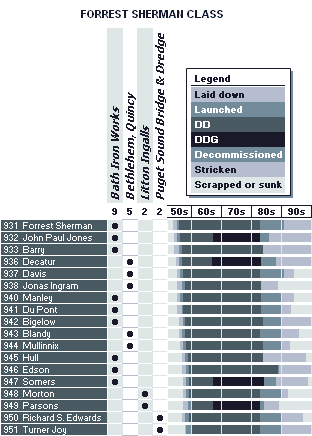

The eighteen ships of the class were the last destroyers completed without guided missiles but played a transitional role. Superseded by the guided-missile-carrying Charles F. Adams class when they were relatively new, it was not long before they were modified. Decatur, equipped with a Tartar missile launcher replacing her after 5-inch guns, was redesignated guided missile destroyer DDG 31 in 1966; John Paul Jones, Parsons and Somers followed as DDGs 32, 33 and 34 in 1967.
Other modifications also affected their appearance. All except the first three had their freeboard increased by three feet at the bow during construction. Later, the 14 ships not modified to carry missiles were refitted with an SQS-23 bow-mounted sonar, at which time most of these were refitted with more sharply-raked stems and a centerline anchor to clear the underwater sonar dome.
Length: 418' 6" overall; 407' 0" waterline.
Beam: 44' 11½".
Draft: 15' mean.
Displacement: 2,734 long tons light; 4,916 long tons full load.
Propulsion machinery: geared steam turbines, 70,000 shp; 2 shafts.
Design speed: 33 knots.
Endurance: 4,500 nm @ 20 knots.
Design complement: 324.
Initial armament: 3 x 5-inch/54 caliber rapid fire; 4 x 3-inch/50 caliber. ASW: 4 x torpedo tubes; ASROC; 2 Hedgehog mounts; DASH.
The Forrest Shermans served into the 1980s, when they decommissioned as the larger Spruance-class destroyers came into service. Most remained on the Navy List until the end of the decade; seven remained unscrapped at the end of the 1990s.
Three have been preserved as museum ships: Barry at the Washington Navy Yard, Edson now withdrawn to Philadelphia from the Intrepid Sea, Air & Space Museum in New York City awaiting another assignment, and Turner Joy on the boardwalk at Bremerton, Washington.
Sources: Bauer & Roberts, Friedman, Silverstone; Global Security.